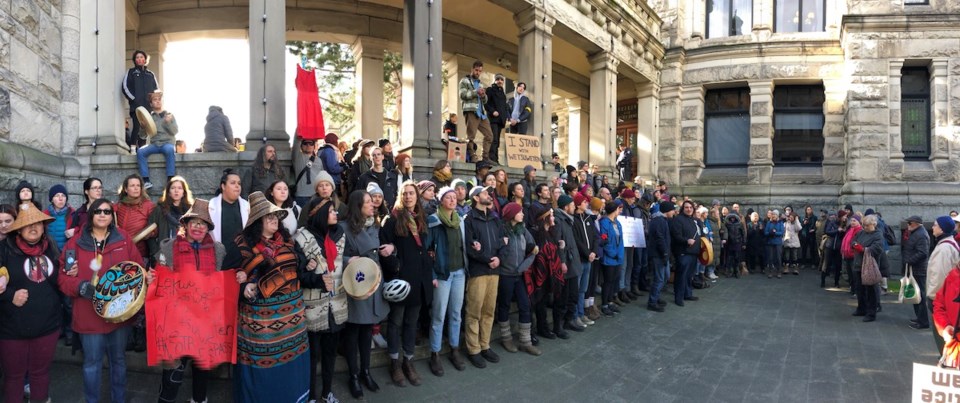Victoria councillors who went to Tuesday’s protest at the legislature — including one who later got into a social-media scrap with the chief of police — were not there representing the city, says Mayor Lisa Helps.
Ben Isitt, Sharmarke Dubow and Jeremy Loveday attended the protest, where provincial staff and politicians were temporarily blocked from entering the building ahead of the throne speech.
The protests, in support of Wet’suwet’en hereditary chiefs who oppose the Coastal GasLink pipeline, disrupted the ceremonies associated with the throne speech, which was read by Lt.-Gov. Janet Austin.
“Councillors are free to do whatever they feel they need to do, but they were not sent there, officially, to represent the city in any capacity,” Helps said.
The mayor declined to comment on a social-media exchange between Isitt and Victoria Police Chief Del Manak.
In response to a Twitter message that police were investigating reports about people, including B.C. legislature staff, being assaulted and injured during the protest, Isitt wrote: “I was there all day observing interactions between the public and legislative officials. This allegation is #hogwash designed to discredit Indigenous youth and their supporters. VicPD’s mandate is to ensure public safety, not spread #fakenews.”
In response, Manak called Isitt’s comments “off base and disrespectful. We are asking victims (and witnesses) to step forward if they were assaulted during the protest. Our mandate is public safety. Please let us do our job. I am proud of the exceptional work of [Victoria police] officers #proudchief.”
On Wednesday, Isitt said on Twitter that he stood by his comments, which “respond to a growing problem of ‘mission creep’ with VicPD management, engaging in a PR campaign against peaceful demonstrators, city councillors & others advocating for change. These kind of political communications are outside of VicPD’s mandate.”
Victoria police said four people reported assaults from the legislature protest — three received non-life-threatening injuries and the fourth was not physically injured but had equipment damaged.
B.C. Premier John Horgan was asked about Isitt’s expression of support for the protesters in light of reports that some staffers were injured as they tried to enter the legislature.
“My thoughts on that individual aren’t printable,” Horgan said. “I will say that I spoke with Mayor Helps today and assured her that I do not view the city council of Victoria as a mirror image of Mr. Isitt. He will carry on living his life the way he does and we’ll have to reckon with that as time goes by. I am again going to focus on the positive.
“I give full marks to Mayor Helps, who made it abundantly clear that she and her council did not support the views of Mr. Isitt on these matters.”
Helps said she was in touch with the police on Tuesday, as well as with someone who was at the protest supporting the Indigenous youth.
A small group of Indigenous protesters were doing their best to keep the peace at the demonstration, she said.
“I think for the most part, things were really peaceful and that’s certainly what the Indigenous youth called for. But if there were people who were injured, there were people who were injured,” Helps said. “I think we can’t pretend the reality isn’t what it is.”
By Wednesday morning, the protesters had removed their camp at the legislataure.
Organizer Saul Brown said the group has “chosen to not give the satisfaction to the RCMP or [Victoria police] of arresting us and detaining us.”
But the movement is not going away, he said. “We shut down the ceremonial procession for the lieutenant-governor,” he said. “I think we shook the very core of that colonial institution.”
A message on social media Wednesday referred to “a major action” on Friday from 8 a.m. to noon, with the goal of shutting down as many government ministries as possible. People were invited to sign up to participate at a wide range of government ministries.
The B.C. Government and Service Employees’ Union issued a statement saying that it is not affiliated with the organizers and the union is not participating in the planned protests on Friday.
Brown said supporters will continue to “shut down Canada,” targeting major corridors, offices and banks.
“I believe the people of British Columbia and Canada are starting to hold elected officials accountable and starting to stand with Indigenous people, so we don’t have to fight this fight alone,” he said. “When they came for our children and residential schools, we fought that alone.”
Horgan issued a statement Tuesday saying that he supports the right to protest within the law, but also understands the frustration of those unable to get to work, enter government buildings or get around in their communities.
Brown accused Horgan of “hiding behind the rule of law,” which he called a “perpetuation of colonization.”
“We know rule of law does not always align with morality, because at one time, potlatch bans were the rule of law.”
Tuesday had marked the sixth day Indigenous youth had been at the legislature in support of the Wet’suwet’en hereditary chiefs, who oppose construction of the Coastal GasLink pipeline, a key part of the $40-billion LNG Canada liquefied-natural-gas export project. The pipeline, which will run 670 kilometres from Dawson Creek to Kitimat in northern B.C., has been approved by the federal and provincial governments, as well as all 20 elected Indigenous councils along the route, including five Wet’suwet’en councils representing almost 3,000 people.
The protesters support the hereditary chiefs’ position that they have jurisdiction and authority over the traditional territory.
In a controversial move, Victoria council voted 6-1 last month to endorse a declaration calling on the provincial and federal governments to take action to “end any attempt at forced removal of the Wet’suwet’en People from their traditional territories.”
— With files from Jeff Bell



